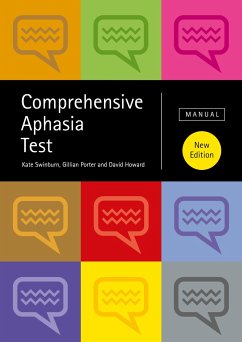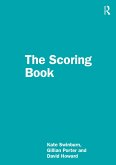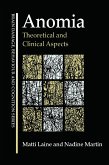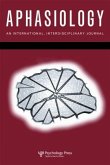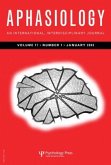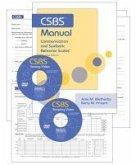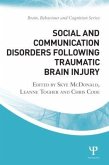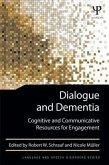- Broschiertes Buch
- Merkliste
- Auf die Merkliste
- Bewerten Bewerten
- Teilen
- Produkt teilen
- Produkterinnerung
- Produkterinnerung
The Comprehensive Aphasia Test (CAT) is a test for people who have acquired aphasia and can be completed over one or two assessment sessions. The test includes a user manual, a ring-bound cognitive screen and language battery a scoring booklet, and a concise Aphasia Impact Questionnaire which replaces the former Disability Questionnaire.
Andere Kunden interessierten sich auch für
![Comprehensive Aphasia Test Comprehensive Aphasia Test]() Kate SwinburnComprehensive Aphasia Test60,99 €
Kate SwinburnComprehensive Aphasia Test60,99 €![Anomia Anomia]() Matti LaineAnomia72,99 €
Matti LaineAnomia72,99 €![Issues in Bilingual Aphasia Issues in Bilingual Aphasia]() Issues in Bilingual Aphasia46,99 €
Issues in Bilingual Aphasia46,99 €![Quality of Life in Aphasia Quality of Life in Aphasia]() Audrey Holland / Linda Worrall (eds.)Quality of Life in Aphasia48,99 €
Audrey Holland / Linda Worrall (eds.)Quality of Life in Aphasia48,99 €![Communication and Symbolic Behavior Scales (Csbs), Normed Edition, Test Kit Communication and Symbolic Behavior Scales (Csbs), Normed Edition, Test Kit]() Amy M WetherbyCommunication and Symbolic Behavior Scales (Csbs), Normed Edition, Test Kit262,99 €
Amy M WetherbyCommunication and Symbolic Behavior Scales (Csbs), Normed Edition, Test Kit262,99 €![Social and Communication Disorders Following Traumatic Brain Injury Social and Communication Disorders Following Traumatic Brain Injury]() Social and Communication Disorders Following Traumatic Brain Injury78,99 €
Social and Communication Disorders Following Traumatic Brain Injury78,99 €![Dialogue and Dementia Dialogue and Dementia]() Dialogue and Dementia83,99 €
Dialogue and Dementia83,99 €-
-
-
The Comprehensive Aphasia Test (CAT) is a test for people who have acquired aphasia and can be completed over one or two assessment sessions. The test includes a user manual, a ring-bound cognitive screen and language battery a scoring booklet, and a concise Aphasia Impact Questionnaire which replaces the former Disability Questionnaire.
Hinweis: Dieser Artikel kann nur an eine deutsche Lieferadresse ausgeliefert werden.
Hinweis: Dieser Artikel kann nur an eine deutsche Lieferadresse ausgeliefert werden.
Produktdetails
- Produktdetails
- Verlag: Taylor & Francis Ltd
- 2. Auflage
- Seitenzahl: 200
- Erscheinungstermin: 15. März 2023
- Englisch
- Abmessung: 306mm x 414mm x 122mm
- Gewicht: 4296g
- ISBN-13: 9780367761615
- ISBN-10: 0367761610
- Artikelnr.: 62574689
- Herstellerkennzeichnung
- Libri GmbH
- Europaallee 1
- 36244 Bad Hersfeld
- gpsr@libri.de
- Verlag: Taylor & Francis Ltd
- 2. Auflage
- Seitenzahl: 200
- Erscheinungstermin: 15. März 2023
- Englisch
- Abmessung: 306mm x 414mm x 122mm
- Gewicht: 4296g
- ISBN-13: 9780367761615
- ISBN-10: 0367761610
- Artikelnr.: 62574689
- Herstellerkennzeichnung
- Libri GmbH
- Europaallee 1
- 36244 Bad Hersfeld
- gpsr@libri.de
Dr Kate Swinburn is a speech and language therapist and freelance academic. She worked in the NHS and in the charity sector each for 10 years. In the NHS she worked with adults with neurological impairments. At Connect Kate was responsible for training, publications, and national policy. Her academic interests focus on people with acquired communication disability (particularly those with aphasia and dementia), working alongside them during co-produced projects, integrating the social model of disability into the research agenda, especially into outcome measurement. She is a member of the international network Collaboration of Aphasia Trialists supporting the adaptation of both the Comprehensive Aphasia Test and the Aphasia Impact Questionnaire into multiple languages (currently 28). She is an honorary lecturer at University College London and a Fellow of the Royal College of Speech and Language Therapists. Gillian Porter is a Speech and Language Therapist who has worked solely in the NHS. As well as her clinical work she has been the service lead for Speech & Language Therapy across acute, and community services, and county-wide professional lead for Speech and language Therapy. Her special interest is working with adults with neurological disorders. Professor David Howard is both a speech and language therapist and cognitive neuropsychologist. His research is on the cognitive neuropsychology of language, including written and spoken word comprehension and production as well as syntactic processing. Drawing data from both data from people with aphasia, and normal participants and brain imaging he wants to develop good computational models of word processing. He is a Fellow of the Royal College of Speech and Language Therapists.
Acknowledgements
1. Introduction
Aphasia tests
The need for the CAT
The advantages of the CAT
Structure of the CAT
2. Directions for Administration and Rationale
General introduction to administration of the test battery
Detailed guide to rationale and administration of subtests
THE COGNITIVE SCREEN
1. Line bisection
2. Semantic memory
3. Word fluency
4. Recognition memory
5. Gesture object use
6. Arithmetic
THE LANGUAGE BATTERY
Part 1: Language comprehension
7. Comprehension of spoken words
8. Comprehension of written words
9. Comprehension of spoken sentences
10. Comprehension of written sentences
11. Comprehension of spoken paragraphs
Part 2: Expressive language
Repetition
12. Repetition of words
13. Repetition of complex words
14. Repetition of nonwords
15. Repetition of digit strings
16. Repetition of sentences
Spoken language production
17. Naming objects
18. Naming actions
19. Spoken picture description
Reading aloud
20. Reading words
21. Reading complex words
22. Reading function words
23. Reading nonwords
Writing
24. Writing: Copying
25. Writing picture names
26. Writing to dictation
27. Written picture description
THE APHASIA IMPACT QUESTIONNAIRE
General introduction to the rationale and administration of the AIQ
Detailed guide to rationale and administration of subtests
28. Communication
29. Participation
30. Emotional Well-Being
Modality summary scores
The cognitive screen
The language battery
The aphasia impact questionnaire
T-score transformation
3. Interpretation of Results
THE COGNITIVE SCREEN
1. Line bisection
2. Semantic memory
3. Word fluency
4. Recognition memory
5. Gesture object use
6. Arithmetic
THE LANGUAGE BATTERY
Part 1: Language comprehension
7. Comprehension of spoken words
8. Comprehension of written words
9. Comprehension of spoken sentences
10. Comprehension of written sentences
11. Comprehension of spoken paragraphs
Part 2: Expressive language
Repetition
12. Repetition of words
13. Repetition of complex words
14. Repetition of nonwords
15. Repetition of digit strings
16. Repetition of sentences
Spoken language production
17. Naming objects
18. Naming actions
19. Spoken picture description
Reading aloud
20. Reading words
21. Reading complex words
22. Reading function words
23. Reading nonwords
Writing
24. Writing: Copying
25. Writing picture names
26. Writing to dictation
27. Written picture description
THE APHASIA IMPACT QUESTIONNAIRE
28. Communication
29. Participation
30. Emotional well being
THE T-SCORE PROFILE
Example 1: Patient RP
Example 2: Patient UA
Example 3: Patient AC
4. Reliability and Validity
Standardisation samples
T-score transformation
Reliability
Test-retest reliability
Inter-rater reliability
Comparing modality summary scores
Construct validity
The cognitive screen
The language battery
Predictive validity
Concurrent validity
5. Predicting Aphasia Recovery
Introduction
Study design
Subjects
Assessment
Data management
Results
Patterns of recovery
Predicting performance at 12 months
Discussion
Effects of therapy
Comment
References
Appendices
1. Worked examples (subtest 19)
2. Derivation of T-scores from raw scores for cognitive subtests
3. Derivation of T-scores from raw scores for language comprehension
subtests
4. Derivation of T-scores from raw scores for repetition and naming
subtests
5. Derivation of T-scores from raw scores for reading and writing subtests
6. Derivation of T-scores from raw scores for spoken and
written description subtests
7. Derivation of "frontal" T-scores from the relationship between
the scores in word fluency and naming objects
1. Introduction
Aphasia tests
The need for the CAT
The advantages of the CAT
Structure of the CAT
2. Directions for Administration and Rationale
General introduction to administration of the test battery
Detailed guide to rationale and administration of subtests
THE COGNITIVE SCREEN
1. Line bisection
2. Semantic memory
3. Word fluency
4. Recognition memory
5. Gesture object use
6. Arithmetic
THE LANGUAGE BATTERY
Part 1: Language comprehension
7. Comprehension of spoken words
8. Comprehension of written words
9. Comprehension of spoken sentences
10. Comprehension of written sentences
11. Comprehension of spoken paragraphs
Part 2: Expressive language
Repetition
12. Repetition of words
13. Repetition of complex words
14. Repetition of nonwords
15. Repetition of digit strings
16. Repetition of sentences
Spoken language production
17. Naming objects
18. Naming actions
19. Spoken picture description
Reading aloud
20. Reading words
21. Reading complex words
22. Reading function words
23. Reading nonwords
Writing
24. Writing: Copying
25. Writing picture names
26. Writing to dictation
27. Written picture description
THE APHASIA IMPACT QUESTIONNAIRE
General introduction to the rationale and administration of the AIQ
Detailed guide to rationale and administration of subtests
28. Communication
29. Participation
30. Emotional Well-Being
Modality summary scores
The cognitive screen
The language battery
The aphasia impact questionnaire
T-score transformation
3. Interpretation of Results
THE COGNITIVE SCREEN
1. Line bisection
2. Semantic memory
3. Word fluency
4. Recognition memory
5. Gesture object use
6. Arithmetic
THE LANGUAGE BATTERY
Part 1: Language comprehension
7. Comprehension of spoken words
8. Comprehension of written words
9. Comprehension of spoken sentences
10. Comprehension of written sentences
11. Comprehension of spoken paragraphs
Part 2: Expressive language
Repetition
12. Repetition of words
13. Repetition of complex words
14. Repetition of nonwords
15. Repetition of digit strings
16. Repetition of sentences
Spoken language production
17. Naming objects
18. Naming actions
19. Spoken picture description
Reading aloud
20. Reading words
21. Reading complex words
22. Reading function words
23. Reading nonwords
Writing
24. Writing: Copying
25. Writing picture names
26. Writing to dictation
27. Written picture description
THE APHASIA IMPACT QUESTIONNAIRE
28. Communication
29. Participation
30. Emotional well being
THE T-SCORE PROFILE
Example 1: Patient RP
Example 2: Patient UA
Example 3: Patient AC
4. Reliability and Validity
Standardisation samples
T-score transformation
Reliability
Test-retest reliability
Inter-rater reliability
Comparing modality summary scores
Construct validity
The cognitive screen
The language battery
Predictive validity
Concurrent validity
5. Predicting Aphasia Recovery
Introduction
Study design
Subjects
Assessment
Data management
Results
Patterns of recovery
Predicting performance at 12 months
Discussion
Effects of therapy
Comment
References
Appendices
1. Worked examples (subtest 19)
2. Derivation of T-scores from raw scores for cognitive subtests
3. Derivation of T-scores from raw scores for language comprehension
subtests
4. Derivation of T-scores from raw scores for repetition and naming
subtests
5. Derivation of T-scores from raw scores for reading and writing subtests
6. Derivation of T-scores from raw scores for spoken and
written description subtests
7. Derivation of "frontal" T-scores from the relationship between
the scores in word fluency and naming objects
Acknowledgements
1. Introduction
Aphasia tests
The need for the CAT
The advantages of the CAT
Structure of the CAT
2. Directions for Administration and Rationale
General introduction to administration of the test battery
Detailed guide to rationale and administration of subtests
THE COGNITIVE SCREEN
1. Line bisection
2. Semantic memory
3. Word fluency
4. Recognition memory
5. Gesture object use
6. Arithmetic
THE LANGUAGE BATTERY
Part 1: Language comprehension
7. Comprehension of spoken words
8. Comprehension of written words
9. Comprehension of spoken sentences
10. Comprehension of written sentences
11. Comprehension of spoken paragraphs
Part 2: Expressive language
Repetition
12. Repetition of words
13. Repetition of complex words
14. Repetition of nonwords
15. Repetition of digit strings
16. Repetition of sentences
Spoken language production
17. Naming objects
18. Naming actions
19. Spoken picture description
Reading aloud
20. Reading words
21. Reading complex words
22. Reading function words
23. Reading nonwords
Writing
24. Writing: Copying
25. Writing picture names
26. Writing to dictation
27. Written picture description
THE APHASIA IMPACT QUESTIONNAIRE
General introduction to the rationale and administration of the AIQ
Detailed guide to rationale and administration of subtests
28. Communication
29. Participation
30. Emotional Well-Being
Modality summary scores
The cognitive screen
The language battery
The aphasia impact questionnaire
T-score transformation
3. Interpretation of Results
THE COGNITIVE SCREEN
1. Line bisection
2. Semantic memory
3. Word fluency
4. Recognition memory
5. Gesture object use
6. Arithmetic
THE LANGUAGE BATTERY
Part 1: Language comprehension
7. Comprehension of spoken words
8. Comprehension of written words
9. Comprehension of spoken sentences
10. Comprehension of written sentences
11. Comprehension of spoken paragraphs
Part 2: Expressive language
Repetition
12. Repetition of words
13. Repetition of complex words
14. Repetition of nonwords
15. Repetition of digit strings
16. Repetition of sentences
Spoken language production
17. Naming objects
18. Naming actions
19. Spoken picture description
Reading aloud
20. Reading words
21. Reading complex words
22. Reading function words
23. Reading nonwords
Writing
24. Writing: Copying
25. Writing picture names
26. Writing to dictation
27. Written picture description
THE APHASIA IMPACT QUESTIONNAIRE
28. Communication
29. Participation
30. Emotional well being
THE T-SCORE PROFILE
Example 1: Patient RP
Example 2: Patient UA
Example 3: Patient AC
4. Reliability and Validity
Standardisation samples
T-score transformation
Reliability
Test-retest reliability
Inter-rater reliability
Comparing modality summary scores
Construct validity
The cognitive screen
The language battery
Predictive validity
Concurrent validity
5. Predicting Aphasia Recovery
Introduction
Study design
Subjects
Assessment
Data management
Results
Patterns of recovery
Predicting performance at 12 months
Discussion
Effects of therapy
Comment
References
Appendices
1. Worked examples (subtest 19)
2. Derivation of T-scores from raw scores for cognitive subtests
3. Derivation of T-scores from raw scores for language comprehension
subtests
4. Derivation of T-scores from raw scores for repetition and naming
subtests
5. Derivation of T-scores from raw scores for reading and writing subtests
6. Derivation of T-scores from raw scores for spoken and
written description subtests
7. Derivation of "frontal" T-scores from the relationship between
the scores in word fluency and naming objects
1. Introduction
Aphasia tests
The need for the CAT
The advantages of the CAT
Structure of the CAT
2. Directions for Administration and Rationale
General introduction to administration of the test battery
Detailed guide to rationale and administration of subtests
THE COGNITIVE SCREEN
1. Line bisection
2. Semantic memory
3. Word fluency
4. Recognition memory
5. Gesture object use
6. Arithmetic
THE LANGUAGE BATTERY
Part 1: Language comprehension
7. Comprehension of spoken words
8. Comprehension of written words
9. Comprehension of spoken sentences
10. Comprehension of written sentences
11. Comprehension of spoken paragraphs
Part 2: Expressive language
Repetition
12. Repetition of words
13. Repetition of complex words
14. Repetition of nonwords
15. Repetition of digit strings
16. Repetition of sentences
Spoken language production
17. Naming objects
18. Naming actions
19. Spoken picture description
Reading aloud
20. Reading words
21. Reading complex words
22. Reading function words
23. Reading nonwords
Writing
24. Writing: Copying
25. Writing picture names
26. Writing to dictation
27. Written picture description
THE APHASIA IMPACT QUESTIONNAIRE
General introduction to the rationale and administration of the AIQ
Detailed guide to rationale and administration of subtests
28. Communication
29. Participation
30. Emotional Well-Being
Modality summary scores
The cognitive screen
The language battery
The aphasia impact questionnaire
T-score transformation
3. Interpretation of Results
THE COGNITIVE SCREEN
1. Line bisection
2. Semantic memory
3. Word fluency
4. Recognition memory
5. Gesture object use
6. Arithmetic
THE LANGUAGE BATTERY
Part 1: Language comprehension
7. Comprehension of spoken words
8. Comprehension of written words
9. Comprehension of spoken sentences
10. Comprehension of written sentences
11. Comprehension of spoken paragraphs
Part 2: Expressive language
Repetition
12. Repetition of words
13. Repetition of complex words
14. Repetition of nonwords
15. Repetition of digit strings
16. Repetition of sentences
Spoken language production
17. Naming objects
18. Naming actions
19. Spoken picture description
Reading aloud
20. Reading words
21. Reading complex words
22. Reading function words
23. Reading nonwords
Writing
24. Writing: Copying
25. Writing picture names
26. Writing to dictation
27. Written picture description
THE APHASIA IMPACT QUESTIONNAIRE
28. Communication
29. Participation
30. Emotional well being
THE T-SCORE PROFILE
Example 1: Patient RP
Example 2: Patient UA
Example 3: Patient AC
4. Reliability and Validity
Standardisation samples
T-score transformation
Reliability
Test-retest reliability
Inter-rater reliability
Comparing modality summary scores
Construct validity
The cognitive screen
The language battery
Predictive validity
Concurrent validity
5. Predicting Aphasia Recovery
Introduction
Study design
Subjects
Assessment
Data management
Results
Patterns of recovery
Predicting performance at 12 months
Discussion
Effects of therapy
Comment
References
Appendices
1. Worked examples (subtest 19)
2. Derivation of T-scores from raw scores for cognitive subtests
3. Derivation of T-scores from raw scores for language comprehension
subtests
4. Derivation of T-scores from raw scores for repetition and naming
subtests
5. Derivation of T-scores from raw scores for reading and writing subtests
6. Derivation of T-scores from raw scores for spoken and
written description subtests
7. Derivation of "frontal" T-scores from the relationship between
the scores in word fluency and naming objects

